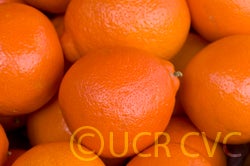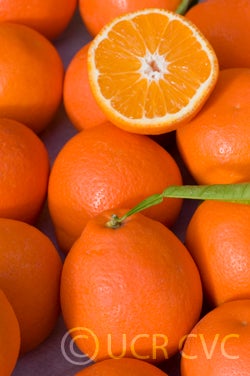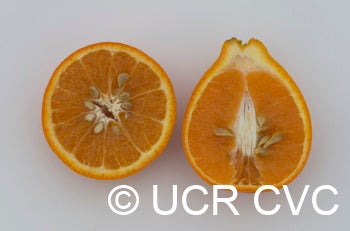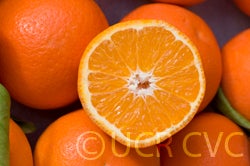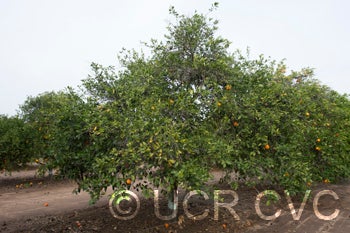Citrus × tangelo
CRC 3340
PI 539709
VI 174 (The CVC does not have VI 20 or VI 208)
Source
Received as budwood from John Carpenter, USDCS, Indio, CA, 1961. Carpenter received budwood from USDA Station at Weslaco, Texas, 1958-1960.
Parentage/origins
Minneola is a tangelo, a hybrid of Duncan grapefruit and Dancy mandarin, sometimes marketed under the name Honeybell. It was developed by the U. S. Department of Agriculture and released in 1931.
Rootstocks of accession
Carrizo citrange, C-35 citrange
Season of ripeness at Riverside
January to March
Notes and observations
The tree grows vigorously to a large size. The fruit is round with a pronounced neck and smooth red-orange rind that can be peeled. The flavor is rich and juicy, with a touch of its grapefruit parent’s tartness. Minneola should be harvested late in the season to ensure the fruit reaches a desirable sugar to acid ratio. Minneola blossoms are self-incompatible and must be cross-pollinated by a suitable pollinator to assure good fruit set. Most mandarin-types are suitable pollinators, with the exception of Satsumas and Minneola’s siblings, Orlando and Seminole. Unfortunately, when cross-pollinated, Minneola’s fruits tend to be seedy.
Description from The Citrus Industry Vol. 1 (1967)
"Fruit large, oblate to obovate; neck usually fairly prominent; seeds comparatively few, with greenish cotyledons. Rind color deep reddish-orange; medium-thin, with smooth, finely pitted surface, and moderately adherent (not loose-skin). Segments 10 to 12 and axis small and hollow. Flesh orange-colored; tender, juicy, aromatic; flavor rich and tart. Medium late in maturity.
Tree vigorous and productive with large, long-pointed leaves. Less cold-resistant than Orlando. Cross-pollination recommended for regular and heavy production. Dancy, Clementine, and Kinnow mandarins appear to be satisfactory pollinators. Orlando tangelo is cross-incompatible.
Minneola is a hybrid of Duncan grapefruit and Dancy tangerine produced in Florida by the U.S. Department of Agriculture and named and released in 1931. Its attractive color, excellent flavor, and low seed content have popularized it in Florida where it is currently of limited commercial importance. There is increasing interest in its culture in the low elevation desert regions of Arizona and California, where total plantings were reported to be 594 acres in 1964."
Availability
Commercially available in California through the Citrus Clonal Protection Program. Click here to order budwood.
USDA Germplasm Resources Information Network page for Minneola tangelo
